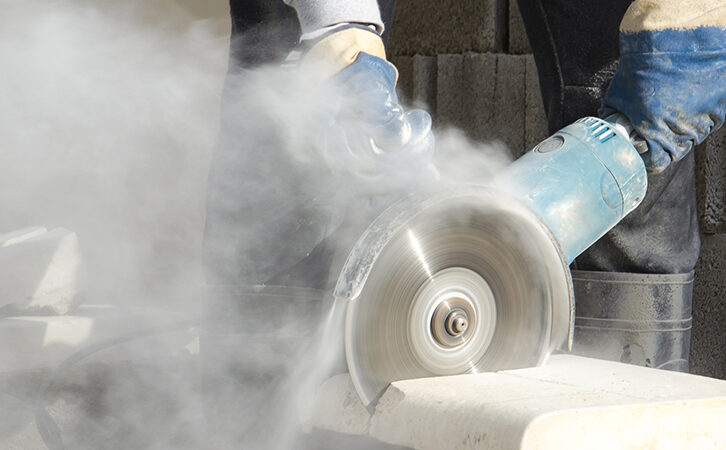If you haven’t noticed, OSHA has been following through on its commitment to do more to update, create and modify guidance provisions, at least in the way of providing new guidance documentation. The agency has released two new guidance publications in recent months, both happen to address dust-particle dangers. The latest document, Controlling Silica Exposures in Construction, provides recommendations for preventing worker overexposure to crystalline silica. It includes effective work practices and engineering controls for construction-related tasks, such as utilizing wet-cutting and vacuum-dust collection systems.
Unlike the combustibility hazards associated with the dust particles referenced in the other guidance document, Hazard Communication Guidance for Combustible Dusts, the hazards associated with silica airborne particles involve the respiratory function of exposed workers.
According to the National Institute for Occupational Safety and Health (NIOSH), exposure to respirable crystalline silica is a risk for a whopping 1.7 million U.S. workers. This is a considerable number and is territory that OSHA has been carefully assessing.
OSHA and Silica
In addition to putting a guidance document together, OSHA also initiated a National Emphasis Program (NEP) for crystalline silica in early 2008, Directive CPL 03-00-007, which builds on a 1996 Special Emphasis Program (SEP) for Silicosis. According to OSHA, the purpose of the NEP is “to identify and reduce or eliminate the health hazards associated with occupational exposure to crystalline silica.”
Regarding compliance, if your company uses materials containing 0.1 percent or more crystalline silica, then you are covered by OSHA’s Hazard Communication Standard (HCS, HazCom, 29 CFR 1910) and must provide: material safety data sheets, proper warning labels and employee training.
You must also adhere to the permissible exposure limit (PEL), 29 CFR 1926.55, 1910.1000, that OSHA has set for this hazardous compound. The PEL represents the maximum amount of crystalline silica that employees can be exposed to during an eight-hour work shift. The limit varies by the composition of the airborne dust present at a particular construction site, and the dust composition is affected by the type of material in use, the silica concentration found in that material, and the environmental factors impacting the worksite ( i.e., open or enclosed space, wind or no wind, etc).
If you’d like more details about OSHA’s PEL calculation for crystalline silica, visit the agency’s Silica eTool, or for a snapshot of regulatory standards related to the hazardous dust, click here.
NOTE: According to the new guidance document, OSHA is still in the process of reviewing silica PELs for both the construction and general industries. However, in this publication, the agency references a PEL benchmark of 0.1mg/m3 (milligrams per cubic meter of air) per eight-hour time-weighted average (TWA).
Science-class Summary of Silica
We thought it would be beneficial to provide a quick and easy-to-understand scientific summary of what silica is, so here it goes. Silica is a naturally-occurring mineral compound made of oxygen and silicon; the two most abundant elements on earth (oxygen being the most abundant, and silicon being the second).
You’re probably familiar with the most common type of silica, quartz. Two other major types of silica are cristobalite and tridymite. Quartz happens to be the second most prominent naturally-occurring mineral found on earth, existing in all major rock types and top soils, including granite and sandstone. Some types of quartz you might be familiar with include: amethyst, onyx, Tiger’s eye, rose quartz and citrine.
You’ll find silica in two forms: amorphous (or non-crystalline) and crystal (also referred to as crystalline). It’s the crystalline form that presents the most potential health risk to workers.
This hazardous compound goes by a slew of names, including: crystalline silica, free silica, free crystalline silica, respirable crystalline silica (RCS), crystalline silica dust, quartz dust and respirable quartz.
Where Crystalline Silica Hazards Exist
Some examples of workers with high potential risk for crystalline silica exposure are those involved in: stone cutting, foundry work, sand blasting, concrete mixing, rock drilling, tunneling, jack hammering, glass production, highway repair and mining.
Check out OSHA’s table “Probable Use of Silica” for more examples.
The Dangers of Crystalline Silica
Continuous inhalation of respirable crystalline silica (RCS) can cause a variety of pulmonary diseases. The most common one associated with occupational overexposure is silicosis. Silicosis is a non-reversible, yet preventable, lung disease caused by the accumulation of silica dust particles inside the lungs. These particles build up, irritate, inflame and scar lung tissue, ultimately reducing the body’s ability to extract oxygen.
It is very important to protect employees now, because even after exposure has ceased, the disease progresses. These particles are so dangerous that crystalline silica has been categorized as a known carcinogen.
Quick Links for More Info
Continue to remind your employees about the importance of protecting themselves from inhaling this potentially deadly dust. Below are links to additional information and resources you can use to help control silica dust exposure at your worlplace, including training PowerPoints.
- World Health Organization
- OSHA Library of Crystalline Silica Training Materials and Other Information
You can also contact VelocityEHS at 1.888.362.2007 for information about on-demand Respiratory Protection training.
